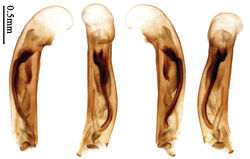Orionella kathmanduensis
| Notice: | This page is derived from the original publication listed below, whose author(s) should always be credited. Further contributors may edit and improve the content of this page and, consequently, need to be credited as well (see page history). Any assessment of factual correctness requires a careful review of the original article as well as of subsequent contributions.
If you are uncertain whether your planned contribution is correct or not, we suggest that you use the associated discussion page instead of editing the page directly. This page should be cited as follows (rationale):
Citation formats to copy and paste
BibTeX: @article{Shi2013ZooKeys284, RIS/ Endnote: TY - JOUR Wikipedia/ Citizendium: <ref name="Shi2013ZooKeys284">{{Citation See also the citation download page at the journal. |
Ordo: Coleoptera
Familia: Carabidae
Genus: Orionella
Name
Orionella kathmanduensis (Kirschenhofer, 1994) comb. n. – Wikispecies link – Pensoft Profile
- Orionella kathmanduensis Kirschenhofer 1994[1]: 1012 (Original: Lachnoderma; type locality: Kathmandu, Nepal; holotype deposited in NHMW).
Non-type material examined
(1 specimen). Nepal: 1 male (CRS), “W Nepal, Gorkha Distrikt, Tharpu-Kali Sundhara Baz., 2000–1300m, 10.6.1993, Leg. J. & J. Probst”[Figs 29, 93, 109].
Diagnosis
Elytra dark brown, disc with an indistinct reddish patch; pronotum with lateral margins slightly sinuate before hind angles; hind angles slightly sharp, subrectangular; internal sac of aedeagus with scaled area shorter than one-fourth length of median lobe. This species can be distinguished from other species of the genus by differences in pronotal hind angles and elytral pattern. Male genitalia differ from Orionella lewisii in having: (1) scaled area on internal sac very short, less than one-fourth length of median lobe; (2) apical lamella only slightly bent backwards.
Description
Body length 8.3 mm; head and pronotum reddish brown, lateral explanate areas of pronotum paler, vertex somewhat deeper; elytra mostly dark brown, disc with an indistinct large reddish patch ranging from basal one-fifth to three-fifths, and occupying the inner five intervals; elytral lateral margins yellowish brown; mouthparts, antennae and legs reddish brown, apices of terminal palpomeres yellow; ventral side uniform reddish brown. Dorsal side evenly and densely pubescent, pubescence yellowish; microsculpture indistinct. Head with vertex nearly flat; tempora slightly longer than half length of eyes, slightly tumid behind eyes; labrum widened to apex, apical margin distinctly bilobed. Pronotum wider than head, cordiform, ratio PW/PL 1.65; pronotal base weakly lobed; front angles widened; lateral margins completely rounded and strongly expanded in middle; widest slightly before middle; lateral margins slightly sinuate before hind angles; hind angles subrectangular, slightly sharp; disc slightly convex; lateral explanate areas wide; basal foveae wide and shallow; median line fine, nearly reaching basal and apical margins; disc not rugose. Elytra slightly widened to apex; striae distinct, finely punctate; 3rd interval with four primary setigerous pores, basal three hardly visible, placed in middle of interval, apical one distinct, adjacent to 2nd stria; 5th interval with one large setigerous pore near base, adjacent to 5th stria, the remainder nearly invisible; discal depression very shallow; umbilical series of 9th interval composed of 16 pores. Male genitalia with median lobe of aedeagus tubular, not laterally compressed, slightly bent to right side in dorsal view; apical lamella small, placed at right side of apex, distinctly pointed forward, apex only slightly bent backward. Internal sac with main flagellum slightly thickened, slightly sinuous, curved to right side, abruptly terminated before apical orifice; trumpet-form expansion small, slightly widened; secondary flagellum weakly sclerotized, half length of median lobe; internal sac with a small area strongly and coarsely scaled near middle, shorter than one-fourth length of median lobe (Fig. 93). Female genitalia not studied.
Distribution
(Map 8). Nepal.
Remarks
We didn’t examine the holotype of Lachnoderma kathmanduense Kirschenhofer deposited in NHMW, but we studied a male from Nepal fitting well with the original description. This species is very similar to Orionella lewisii (Bates) both by external and male genital characters, so we move this species to Orionella Jedlička herein.
Taxon Treatment
- Shi, H; Zhou, H; Liang, H; 2013: Taxonomic synopsis of the subtribe Physoderina (Coleoptera, Carabidae, Lebiini), with species revisions of eight genera ZooKeys, 284: 1-129. doi
Other References
- ↑ Kirschenhofer E (1994) Neue und wenig bekannte Carabidae aus der palaarktischen und orientalischen Region (Col., Carabidae, Lebiinae, Odacanthinae, Brachininae, Panagaeinae). Linzer Biologische Beiträge 26 (2): 999-1067.
Images
|



